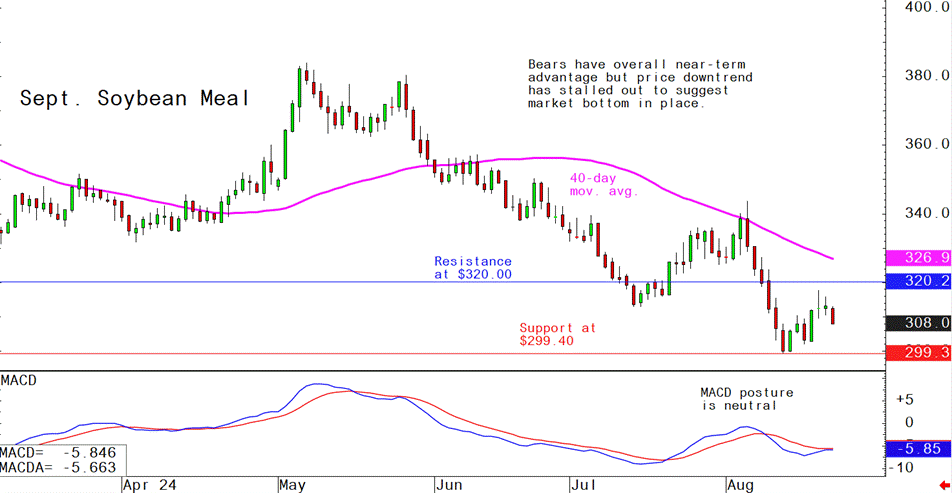



Pig outlook: Lean hog futures recovering from August lows
Livestock analyst Jim Wyckoff reports on global pig newsOctober lean hog futures Wednesday hit a nearly four-week high and then backed off. The near-term technical posture for the lean hog futures market is neutral, amid sideways and choppy trading. Look for more of the same in the near term. Fundamentally, wholesale pork prices are declining. The latest CME lean hog index dropped another 50 cents to $89.21, though is still 83 cents above the July low.
Latest USDA and other news regarding the global pork industry
Weekly USDA pork export sales
Pork: Net US sales of 19,300 MT for 2024--a marketing-year low--were down 7 percent from the previous week and 34 percent from the prior 4-week average. Increases were primarily for Mexico (4,700 MT, including decreases of 100 MT), Canada (3,100 MT, including decreases of 600 MT), Japan (3,000 MT, including decreases of 700 MT), Colombia (2,100 MT, including decreases of 200 MT), and China (1,400 MT, including decreases of 100 MT). Net sales of 200 MT for 2025 were reported for Australia (100 MT) and Japan (100 MT). Exports of 28,800 MT were unchanged from the previous week, but down 8 percent from the prior 4-week average. The destinations were primarily to Mexico (12,900 MT), Japan (3,900 MT), China (2,300 MT), Colombia (2,100 MT), and Canada (2,000 MT).
USDA annual report on China pork industry
Swine Production: USDA’s attache (post) forecasts China swine production in 2025 to grow marginally due to a higher sow inventory in 2024.
Swine Imports: Post forecasts China swine imports in 2025 to be stable from 2024. The consensus is that China’s swine herd has recovered following its decimation by African swine fever (ASF) that continued through to 2021 and that integrated pork industry members have improved herd management. Additionally, sow numbers are being met mostly by domestic breeds and complemented by modest imports.
Pork Production: Post forecasts China pork production to decline in 2025 because of expected fewer swine for slaughter and weak pork demand. Post expects pork production in the second half of 2025 to be higher than in the first half as swine companies react to price signals in late 2024 and early 2025 to begin increasing production.
Pork Imports: Post forecasts pork imports in 2025 to remain flat because of weak consumer demand in the sluggish economy. In addition, industry sources report imported pork has not been moving as quickly through the market as before and traders appear to have adequate inventories
Russian pork producers target EU’s share of China's pork market
The move adds to the growing economic ties between Russia and China in the face of increasing sanctions against both countries by the West.
Recent discussions emerge on accusations of price gouging in the US food industry
- Food industry's stance: Representatives from the food industry, including the National Grocers Association and FMI, The Food Industry Association, have rejected accusations of price gouging. They argue that high input costs are the primary reason for increased grocery prices, not deceptive practices. Greg Ferrara, president and CEO of the National Grocers Association, emphasized that independent grocers are also affected by inflationary pressures and called for a focus on reducing credit card fees and regulations instead of implementing a price gouging ban. Leslie Sarasin, President and CEO of FMI, stated that the food industry has zero tolerance for price gouging and highlighted that grocery stores operate on tight profit margins.
- Political proposals: Vice President Kamala Harris has proposed a federal ban on price gouging in the food industry, arguing that it would prevent businesses from exploiting crises to charge excessive prices. However, some economists and critics argue that such a ban could lead to unintended consequences, such as discouraging new market entrants and potentially maintaining the status quo. The proposal is part of a broader agenda aimed at reducing costs for consumers, including food, housing, and medicine.
- Economic and political context: Under the Biden/Harris administration, food prices increased significantly, contributing to public dissatisfaction with the economy. While inflation is reportedly moderating, grocery prices remain a concern for many voters. Some economists suggest that addressing barriers to market entry and focusing on anti-competitive behaviors might be more effective than implementing price gouging bans.
The next week’s likely high-low price trading ranges:
October lean hog futures--$71.325 to 78.70 and with a sideways bias
September soybean meal futures--$295.00 to $320.00, and with a sideways-lower bias
December corn futures--$3.85 to $4.15 and a sideways bias












